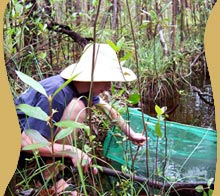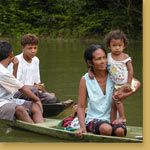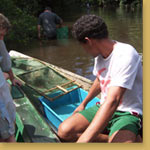“Buy a Fish, Save a Tree!”
Project Piaba is a community based interdisciplinary project established to protect the Amazonian Rainforest from destructive land use by promoting ornamental fishing as a commercially viable trade along the Amazon Basin. Villagers along the Rio Negro rely heavily on fishing for their livelihood. These fishermen seek ornamental fish, such as tetras, cichlids and small catfish that they call “piabas.” These fish are exported all over the world for the lucrative aquarium fish trade. Exporters and wholesalers profit most from the catch, providing little compensation to the local fishermen.
|
 |
 If not for ornamental fish collecting, villagers would be forced into trades destructive to the surrounding rainforest such as cattle ranching and logging. To encourage the development of a sustainable fishery and at the same time, save the forest, Project Piaba was formed in 1989. The Project Piaba team trains fishermen on fish handling skills, provides needed equipment and organizes the fishermen into a “union” of sorts, empowering them to negotiate equitable prices and terms for their sales. To assist in their mission, Project Piaba recruits biologists, veterinarians and other professionals with expertise in aquarium fish keeping, to travel on expeditions along the Rio Negro. The research is essential for ensuring that the fishery does not disturb the delicate balance of the rainforest and river ecosystems. If not for ornamental fish collecting, villagers would be forced into trades destructive to the surrounding rainforest such as cattle ranching and logging. To encourage the development of a sustainable fishery and at the same time, save the forest, Project Piaba was formed in 1989. The Project Piaba team trains fishermen on fish handling skills, provides needed equipment and organizes the fishermen into a “union” of sorts, empowering them to negotiate equitable prices and terms for their sales. To assist in their mission, Project Piaba recruits biologists, veterinarians and other professionals with expertise in aquarium fish keeping, to travel on expeditions along the Rio Negro. The research is essential for ensuring that the fishery does not disturb the delicate balance of the rainforest and river ecosystems.
 Each year, the WAVE Foundation hosts a fundraiser to send Newport Aquarium biologists to the Amazon to join the Project Piaba’s
research team. The fundraiser, Party for Piaba, includes a silent
auction of authentic Amazonian crafts, live entertainment and
the opportunity to speak with the expedition biologists and hear
stories of their travels. Each year, the WAVE Foundation hosts a fundraiser to send Newport Aquarium biologists to the Amazon to join the Project Piaba’s
research team. The fundraiser, Party for Piaba, includes a silent
auction of authentic Amazonian crafts, live entertainment and
the opportunity to speak with the expedition biologists and hear
stories of their travels.  Newport Aquarium biologists have been
an indispensable part of the Rio Negro expedition. In January,
Newport Aquarium biologists will once again return to the Amazon
to assist with Project Piaba’s mission to save the rainforest. Newport Aquarium biologists have been
an indispensable part of the Rio Negro expedition. In January,
Newport Aquarium biologists will once again return to the Amazon
to assist with Project Piaba’s mission to save the rainforest.
To learn more about Project Piaba, visit their web site at: www.opefe.com.

Read more about Project Piaba on the project’s web site: www.angelfire.com/pq/piaba
Attend Party for Piaba 2007- Date TBD
Donate items for our biologists to take to local schools and
villages in the Amazon. Suggested items include: |
| • |
Girls’ hair accessories (barrettes, bows, hair bands) |
| • |
Band-aids |
| • |
Matchbox cars and small toys (no stuffed animals please) |
| • |
School supplies |
| • |
Clothing for infants-teens (warm weather) |
| • |
Baseball caps |
| • |
Polaroid film |
| • |
Fishing line and small fishing hooks |
| |
If you have items to donate, please call 859.815.1448 to arrange for drop off. All donations
are tax deductible. Donate to help fund Aquarium biologists to participate
in Project Piaba. |

Covering over 40% of the South American continent, the Amazon rainforest, also called Amazonia, is the largest rainforest in the world.
Located near the equator and fed by the waters of the massive Amazon River, the rainforest is warm and humid year-round with an average
temperature of 79° F, enabling tropical plants and animals to thrive. Biodiversity in the forest
is unparalleled by any other terrestrial environment. In terms of number of species, 300 mammals, 1000 frogs, 500 reptiles, and 1500 or
one third of the world's birds live in Amazonia. Over 50,000 species of insects can be found in a single square mile of forest. Likewise,
the Amazon River and its tributaries support a wealth of aquatic species. Over 3,000 tropical fish live within the Amazon’s waters
from the world’s largest freshwater fish, the Arapaima, to the inch-long Cardinal Tetra.
Amazonia is not only home to animals and plants; there are many people that live within the cover of the forest and along the river. Humans
are part of the delicate balance of life that maintains the rainforest ecosystem. For thousands of years, indigenous people have lived off
the land, but as the world population grows and natural resources are pushed to their limits, developers and opportunists have sought to use
the forest for short-term profits, by establishing logging operations and clearing land for ranching and agriculture. Frequently, natives
are pressured into joining these trades as they struggle to provide for their families. Each year,
the Amazon rainforest shrinks from clear-cutting and development. It is estimated that 20%
of the original footprint of the rainforest has been lost forever. The good news is that the
rate of destruction seems to be slowing. Efforts such as those of Project Piaba and recent discoveries of disease-fighting compounds in rainforest plants are encouraging countries to enact conservation measures.
|

